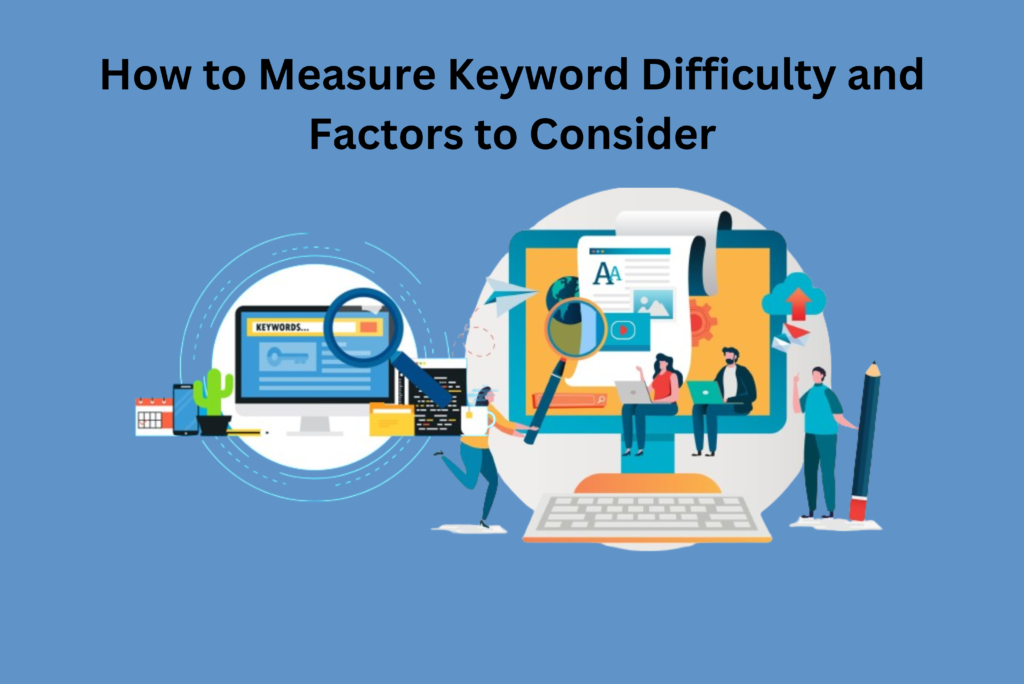
Having trouble deciding which keywords to prioritize It’s a typical SEO difficulty. Of all the keywords you have, which ones should you focus on first? Understanding how much keyword difficulty is good for SEO is crucial for effective search engine optimization.
The most popular strategy is to concentrate on search volume, with the theory being that high-volume keywords will offer the best opportunities. However, search volume by itself is insufficient to convey the difficulty of ranking for a given query in organic search results.
In this blog, we will explore what is keyword difficulty score and how much keyword difficulty is good for SEO.
What Is Keyword Difficulty?
An SEO metric called “keyword difficulty” is used to evaluate how difficult it is to rank for a particular keyword on search engines such as Google.
Determining how much keyword difficulty is good for SEO requires careful analysis of multiple factors. These scores usually show how difficult or easy it is to rank for a specific keyword as a numerical value or a scale (low, medium, high, or from 0-100).
In order to increase their chances of ranking higher in search engine results, SEOs prioritize their keywords or topics based on keyword difficulty scores, giving special attention to keywords with manageable difficulty levels.
Difference Between Keyword Difficulty and Keyword Competition

For SEOs, the idea of keyword difficulty is nothing new. It has spent a significant portion of the last ten years existing in various forms.
But it’s also one of the most misinterpreted aspects of SEO.
First of all, it’s frequently mistaken for keyword competition, which is a term that appears in the Google Keyword Planner. Despite their apparent similarity, the two terms examine two entirely different aspects of your target phrases. Knowing how much keyword difficulty is good for SEO can help marketers prioritize their keyword targeting efforts.
Keyword Competitiveness: describes the amount of competition you may face when bidding on a keyword and is related to paid terms.
Keyword Difficulty score indicates how likely it is that you will appear in the organic search traffic results for a given keyword.
Why is Keyword Difficulty Important When Conducting Keyword Research?
Two primary factors are usually used by SEO teams to rank content opportunities: the level of demand for a topic and the level of difficulty associated with ranking for it in comparison to competitors.
Therefore, how can you determine if you have what it takes to rank for a particular keyword?
This is where keyword difficulty scores come into play.
When optimizing your site for a new topic area, it is usually best to target less difficult keywords with high search volume. These are commonly referred to as “low website traffic” because they are relatively simple ranking opportunities with the potential to rapidly drive traffic to your website.
Focusing on low-website traffic keywords can also provide long-term benefits. When you optimize content for a topic’s longer tail keywords and properly interlink it, you’ll gradually build a topic cluster around it.
As time passes, search engines may recognize your website as an authoritative source on the subject, increasing your chances of ranking for more competitive, high-volume keywords.
What Is a “Good” Keyword Difficulty Score?
To evaluate keyword difficulty, you must look at the keyword difficulty score (KDS). Although this metric is offered by many SEO analytics tools, it is not an official Google metric.
The percentage ranging from one to one hundred represents the keyword difficulty score. The keyword is more competitive the higher the score.
Based on the meaning of the keyword difficulty scores, the following is a general segmentation of keywords.
KDS Over 70% – Keywords with High Difficulty
These are extremely competitive keywords with a high degree of difficulty. You will need to make long-term, significant investments in link-building and SEO if you plan to target these keywords. You can’t start competing for these kinds of keywords and start seeing results right away.
Related: How AI Will Revolutionize The Future Of SEO
It takes time and money to successfully compete for keywords with such high difficulty. Implementing a data-driven approach to determine how much keyword difficulty is good for SEO and for your website’s goals yields valuable insights.
KDS Moderately Difficulty Keywords: 30% to 70%
KDS Keywords with moderate difficulty (between 30% and 70%)
Attempting to rank for these keywords is more attainable and profitable. These typically have high search volumes (hence the difficulty), but not enough competition to make it unfeasible.
As a result, these are your best options for choosing the right keywords because you have a good chance of competing for them. They also have a high search volume, so it’s worthwhile to target them.
Keywords with a KDS of less than 30% are considered Low Difficulty
These are the keywords with the lowest difficulty that are easiest to rank for. However, these keywords are rarely searched for consistently. However, if you can find low-difficulty keywords with high search volumes, you’ve hit the jackpot.
Many companies use targeted content in this way. They search for long-tail, niche keywords that are most relevant to their industry and build their content around those. Consistently reassessing how much keyword difficulty is good for SEO helps keep your optimization efforts aligned with industry trends and algorithm updates.
Because long-tail keywords are more tailored to the user’s query, their conversion rates are probably higher.
Mastering how much keyword difficulty is good for SEO and appropriate for your niche is crucial for long-term success.
Compared to broad keywords, they typically have lower difficulty scores and less competition on the search engine results page (SERP), which makes them easier to rank for.
On the other hand, focusing on shorter and more widely used keywords may lead to intense competition, making it more difficult for a website to rank and attract visitors. It is more productive and successful to create content with long-tail keywords in mind to draw in potential clients.
Ultimately, a good keyword difficulty score for your website is determined by its authority, resources, and overall SEO strategy. Achieving a balance between focusing on keywords that are realistic and those with significant traffic potential is crucial. Adapting your SEO approach based on how much keyword difficulty is good for SEO and for your website is necessary for success.
How is the Keyword Difficulty Calculated?
Each keyword research tool has a different formula for determining the keyword difficulty scores. Nonetheless, the same basic elements apply to determining the keyword difficulty score.
Read More: 7 Reasons Why Keyword Research Is Important for Your Business
As was previously mentioned, keyword difficulty indicates how simple or complex it is to rank for a specific keyword. Therefore, the factors used to determine keyword difficulty are similar to those used to determine search engine ranking. Keywords that are difficult to compete for have been identified which improve a page’s ranking factor.
These are the three main factors that are taken into account when determining the keyword difficulty.
1. Content Quality
Since this is one of the most significant elements affecting search engine rankings, it is also taken into account when determining keyword difficulty.
Analyzing how much keyword difficulty is good for SEO helps guide your keyword targeting strategy. You won’t have much luck ranking for your target keyword without quality content. It might not be enough to rank, though, even if your content is well-written and educational.
Your ability to rank can be greatly impacted by making sure that your content is in line with the user’s search intent. This is why relevance is so important.
Because search engines want to show users the most relevant and helpful results possible, pages with high-quality content tend to rank well.
2. Backlinks and Referring Domain Quality
Another significant element that affects a keyword’s difficulty score is the amount and quality of backlinks as well as the number of referring domains.
Related: Link Building Strategies: 15+ Easy Link Building Techniques in SEO for 2024
Strong backlink profiles can help search engines recognize your content as authoritative and reliable, which raises the likelihood that it will rank higher. To outrank your competitors for a particular keyword can be considerably more difficult if they have a well-established backlink profile. On the other hand, over time, having a solid backlink profile can help you remain competitive.
It will be difficult to compete for the keywords that these pages target because overall, pages with a variety of high-quality backlinks rank highly.
3. Domain Authority
Similar to a website’s reputation, domain authority measures how useful and relevant its content is for a given topic or sector. A website is regarded as an authority in its field more so the higher its domain authority.
Marketers should consider their website’s authority and resources when determining how much keyword difficulty is good for SEO.
It is often seen that it takes time for recently established domains to become authoritative. It may be more challenging to convince search engines that your content is superior and more dependable than that of the competition if your website is new and has little page authority.
It will then be more difficult to remove your primary competitors from the top spots if they have a lot of authority and are well-established for the keyword in question.
Furthermore, keywords that are targeted by websites with a high domain authority will have a high difficulty score because these websites rank higher for those keywords. Therefore, domain authority of websites using that keyword is also considered when calculating the difficulty score for each keyword.
The best way to get past this is to be patient and keep creating authoritative content. It should be comprehensive, well-written, informative, and straightforward.
How to Measure Keyword Difficulty: Factors to Consider

This simple procedure will assist you in prioritizing your keywords according to their potential for ranking. It is based on comparing target keywords to the subsequent standards:
Search Volume: Using this metric, you can ascertain how much demand there is for a particular keyword. Finding the interest of the audience and the potential of the keyword is useful.
Search intent: Examine whether the search intent of the user matches the content you want to target or optimize on the page.
Cost per Click: Consider the keyword from a commercial standpoint. Consider the question, “what if the PPC team invested in the keyword, what would the investment, and the potential return be like?”
You can assess your SEO campaign’s ROI and commercial potential by providing an answer to this question. Continuous monitoring of how much keyword difficulty is good for SEO is suitable for your campaign success.
Related: Is SEO Worth It For Small Businesses: Proven SEO Tips
The SERP Signature: Are there any universal search types or features that you could target with the keyword? That could include images, videos, featured snippets, and so on.
Competition’s website ranking for the keyword: do you stand a chance of ranking there if the websites you usually face off against don’t? Or, are you even interested in attending? The majority of the time, the response might be no.
Content of a page: Examine the content that ranks highest to determine the minimum information needed to appear on page one. Does it align with your intended use of the asset?
Using these criteria, you can determine your chances of ranking and the effort required to do so.
However, manually carrying out the process is, at best, inefficient. Furthermore, you could never assess the full range of ranking factors to determine how difficult it would be to rank for that query.
This is why keyword difficulty scores are so useful. However, not all keyword difficulty tools are created equal in terms of accurately determining how difficult it is to rank for your target keywords. Which brings us to…
The Problem with Most Keyword Difficulty Tools
Many keyword difficulty checkers exist, but there is no standardized method for calculating keyword difficulty.
Many SEO tools offer insights into keyword difficulty, helping marketers gauge how competitive a keyword is. Let’s have a look:
- For instance, MOZ combines domain authority—which is determined by the quantity of referring domains—with page authority.
- SEMrush uses three methods to determine the difficulty of a keyword: first, it analyzes the search engine result page (SERP) to determine the strength of the top 10 pages (referring domains, follow/no follow link ratios, and domain authority); second, it analyzes keyword characteristics such as search volume and SERP features; and third, it modifies scores based on regional databases to prevent deviations. But keep in mind that backlinks still account for two-thirds of their score.
- Ahrefs bases its score on the number of links required to rank for a given keyword, counting the number of referring domains.
The problem with those approaches is that they use backlinks as a measure of search engine results page (SERP) competitiveness.
Final Thoughts
Keyword difficulty is an important factor to consider when choosing your target keywords.
It indicates the degree of difficulty or ease with which you can rank for that keyword. It is more difficult to rank for that target keyword the higher the difficulty score.
Additionally, you can sort and filter lengthy keyword lists using the keyword difficulty score to determine which keywords are best for your company.
Also Read: 7 SEO Lead Generation Techniques: How to Generate Leads Through SEO
At WhiteLabel SEO, we recognize the paramount significance of keywords in driving successful search engine optimization (SEO) strategies. Understanding the delicate balance of keyword difficulty is foundational to our approach. We meticulously analyze each keyword’s difficulty level to ensure optimal performance and ranking potential for our clients’ websites.
Do you want to see keyword difficulty in action? Schedule a quick demo today.
How Much Keyword Difficulty is Good for SEO FAQs
Q. What is a good keyword difficulty ranking?
Ans. Low Difficulty (0–30): It's simplest to rank for these keywords. Although they usually have lower search volumes, they are perfect for long-tail keywords or new websites. Medium Difficulty (31–60): There is some competition for these keywords. They frequently strike a balance between competition and search volume.
Q. Should SEO difficulty be high or low?
Ans. You'll struggle to outrank your rivals if you have a lower Authority Score and weaker backlinks. Thus, you should probably start by focusing on keywords with lower difficulty.
